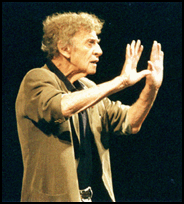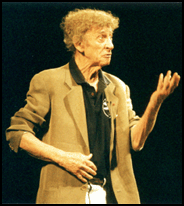One cannot help using words to describe the man known as the master of mime, Marcel Marceau. But even the master himself could not elude speech Tuesday during a visit to UB, articulating-and, of course, gesticulating-"the strong grammar" of mime, which he describes as singing in silence.
"With the breathing of the emotion, you create thought," explained the French-born artist, who spoke to some 400 people from the university and public in the Drama Theatre in the Center for the Arts on UB's North Campus. "Breathing is ... poetry-how to sing inside, the stream of life, the feeling of life.
"When you speak words, you create an image, and when you are silent, the attitude of the moment creates image," he said.
Imagine the facial expressions-or some of what Marceau calls the "conventions of character"-of indifference, dreaming, melancholy, courage, sadness and despair.
| |
 
|
| |
Attitude that reveals emotion: Marcel Marceau delighted a packed audience Tuesday in the Drama Theatre. |
| |
Photos: Stephanie Hamberger |
| |
"These attitudes would be the grammatical attitude to express," Marceau told the packed house, while depicting each not in his usual white face makeup and body costume, but in a beige jacket and ivory slacks, his graying hair mussed in Einstein-like flyaway. Mimes, he said, "learn the attitude which reveals emotion."
What began as a discussion about the history of mime-and Marceau's foray into the art-quickly evolved into a string of vignettes in which, among them, the 77-year-old was perched, arms crossed, over the rail of a cruise ship-swaying to and fro, a face reflective of both giddy pleasure and severe nausea; tore a man's heart out of his chest in a fit of unabated rage, and struggled to walk against the wind-perhaps one of his most familiar "moves," which Marceau said was the inspiration for Michael Jackson's "moonwalk."
The contrast in scenarios is no accident, but a gift of the artist-who appeared happy to indulge the audience-whose expression changes from deranged to docile in a matter of moments.
Speaking to the audience-sometimes in mid-"mime," even-Marceau explained that the "rudiments" of the art-think tug-of-war and walking up and down stairs-are about making the visible invisible, and the invisible visible. Creating the attitude-disdain, compassion, pity-or the element-air, water, fire or earth-has to come from within.
"The grammar is the substance," he said. "You learn to play inside to understand."
Mastering the invisible is in acknowledging that which is not there: "You are always somehow moved by ghosts," he said.
Moved, in childhood, by the likes of silent screen artists Charlie Chaplin and Buster Keaton, Marceau in 1944 enrolled in Charles Dullin's School of Dramatic Art in the Sarah Bernhardt Theatre in Paris, where he studied under Etienne Decroux, considered a master of his time.
"When you have a master, you can become a master," Marceau said. And so the story was written for Marceau, who in 1947 "decided to become a proficient man myself," introducing the highly recognizable character, Bip, a tribute to 19th-century pantomime performer Jean Gaspard Deburau's character, Pierrot.
"I carried the white face not because I played like Pierrot in the 19th century, but I wanted ... people to understand that every art form has a tradition," he said, noting that mime-in many ways, the foundation for acting and dancing-"has been considered the essence of theater."
He also shared with the audience the origin of his character's name. Bip, he said, is derived from Pip, the hopeful protagonist in Charles Dickens' classic, "Great Expectations."
"At 20 years old," he said of himself, "you have great expectations."
And he did much to fulfill his. In 1948, the same year he received the renowned Deburau prize, he formed the only pantomime company in the world at the time, the Compagnie de Mime Marcel Marceau, and was performing in Paris, and throughout Europe, Canada and South America.
Marceau's North American debut at the Stratford Festival in Ontario was the prelude to his first U.S. tour, in 1955 and 1956, an incredible success that set the prolific performance trend that ensued over the next 40 years of Marceau's career.
Still, like the sometimes fleeting expressions and attitudes of the mime, Marceau seems endeared to happiness much the same way.
"I am not unhappy," he explained, pointing out, however, that "happiness is only a moment" that comes and goes, and comes again. And though silence does not truly exist, he said, mime-a metaphor for, or "certain poetry about," reality-affords respite from present conditions, such as hate and war, that weigh heavy on him.
"[It is] so wonderful to live in silence-there is such noise in the world!" he exclaimed, gesturing with his hands-the tools of his livelihood that he said are "so important"-and filling his pause with a crescendo of sound emulating "noise."
Emotional and animated, Marceau's speech circles back always to the "sound" of silence-the gesture.
"The sound reveals the rhythm, the gesture [reveals] inside of man," he said, his preference to quietly bear what is the essence of humanity, or "the weight of the soul."
"Words are words, but actions are much stronger."
The event was presented by the Irish Classical Theatre Company and UB's Center for the Arts, in association with UB's Department of Theatre and Dance, as well as made possible by one of the founders of the Irish Classical Theatre and former student of Marceau's, Vincent O'Neill.
"The reason he's here ... is because ... the Irish Classical Theatre Company presented Marcel Marceau with a Career Lifetime Achievement Award for his extraordinary contribution to the art of the theater, and to the art of mime," remarked O'Neill, who told the crowd Marceau would be back in the spring to perform in Buffalo.


